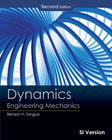
The second edition provides engineers with a conceptual understanding of how dynamics is applied in the field. It builds their problem-solving skills. New problems with a wider variety of difficulty levels and applications have been added. An online problem-solving tool is available to reinforce how to find solutions. New images are included to add a visual element to the material. These show the link between an actual system and a modeled/analyzed system. Engineers will also benefit from the numerous new worked problems, algorithmic problems, and multi-part GO problems. INDICE: Chapter 1. Background and Roadmap. 1.1 Newton's Laws. 1.2 How You'll Be Approaching Dynamics. 1.3 Units and Symbols. 1.4 Gravitation. 1.5 The Pieces of the Puzzle. Chapter 2. Motion of Translating Bodies. 2.1 Straight-LineMotion. 2.2 Cartesian Coordinates. 2.3 Polar and Cylindrical Coordinates. 2.4Path Coordinates. 2.5 Relative Motion and Constraints. 2.6 Just the Facts. Chapter 3. Inertial Response of Translating Bodies. 3.1 Cartesian Coordinates. 3.2 Polar Coordinates. 3.3 Path Coordinates. 3.4 Linear Momentum and Linear Impulse. 3.5 Angular Momentum and Angular. 3.6 Orbital Mechanics. 3.7 Impact. 3.8Oblique Impact. 3.9 Just the Facts. Chapter 4. Energetics of Translating Bodies. 4.1 Kinetic Energy. 4.2 Potential Energies and Conservative. 4.3 Power andEfficiency. 4.4 Just the Facts. Chapter 5. Multibody Systems. 5.1 Force Balance and Linear Momentum. 5.2 Angular Momentum. 5.3 Work and Energy. 5.4 Stationary Enclosures with Mass Inflow and Outflow. 5.5 Nonconstant Mass Systems. 5.6Just the Facts. Chapter 6. Kinetics of Rigid Bodies Undergoing Planar Motion.6.1 Relative Velocities on a Rigid Body. 6.2 Instantaneous Center of Rotation(ICR). 6.3 Rotating Reference Frames and Rigid-Body Accelerations. 6.4 Relative Motion on a Rigid Body. 6.5 Just the Fact. Chapter 7. Kinetics of Rigid Bodies Undergoing Two-Dimensional Motion. 7.1 Curvilinear Translation. 7.2 Rotation about a Fixed Point. 7.3 General Motion. 7.4 Linear/Angular Momentum of Two-Dimensional Rigid Bodies. 7.5 Work/Energy of Two-Dimensional Rigid Bodies. 7.6 Just the Facts. Chapter 8. Kinematics and Kinetics of Rigid Bodies in Three-Dimensional Motion. 8.1 Spherical Coordinates. 8.2 Angular Velocity of Rigid Bodies in Three-Dimensional Motion. 8.3 Angular Acceleration of Rigid Bodies inThree-Dimensional Motion. 8.4 General Motion of and on Three-Dimensional Bodies. 8.5 Moments and Products of Inertia for a Three-Dimensional Body. 8.6 Parallel Axis Expressions for Inertias. 8.7 Angular Momentum. 8.8 Equations of Motion for a Three-Dimensional Body. 8.9 Energy of Three-Dimensional Bodies. 8.10Just the Facts. Chapter 9. Vibratory Motions. 9.1 Undamped, Free Response forSingle-Degree-of-Freedom Systems. 9.2 Undamped, Sinusoidally Forced Response for Single-Degree-of-Freedom Systems. 9.3 Damped, Free Response for Single-Degree-of-Freedom Systems. 9.4 Damped, Sinusoidally Forced Response for Single-Degree-of-Freedom Systems. 9.5 Just the Facts. Appendix A. Numerical IntegrationLight. Appendix B. Properties of Plane and Solid Bodies. Appendix C. Some Useful Mathematical Facts. Appendix D. Material Densities. Bibliography. Index.
- ISBN: 978-0-470-55304-6
- Editorial: John Wiley & Sons
- Encuadernacion: Rústica
- Páginas: 616
- Fecha Publicación: 01/07/2009
- Nº Volúmenes: 1
- Idioma: Inglés
